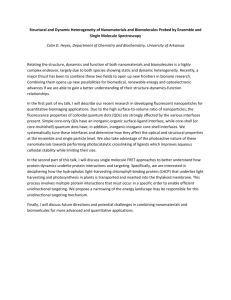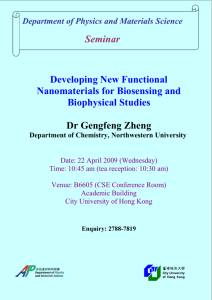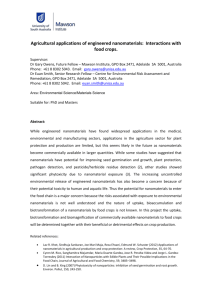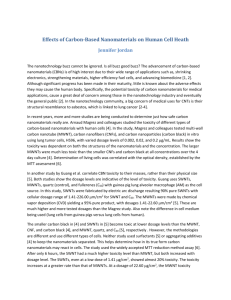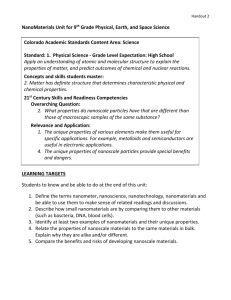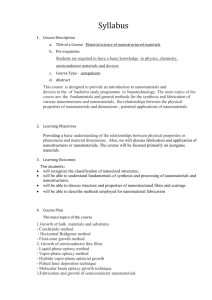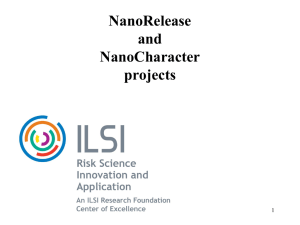Project ID Assignment: HTS-3: High Throughput Screening to
advertisement
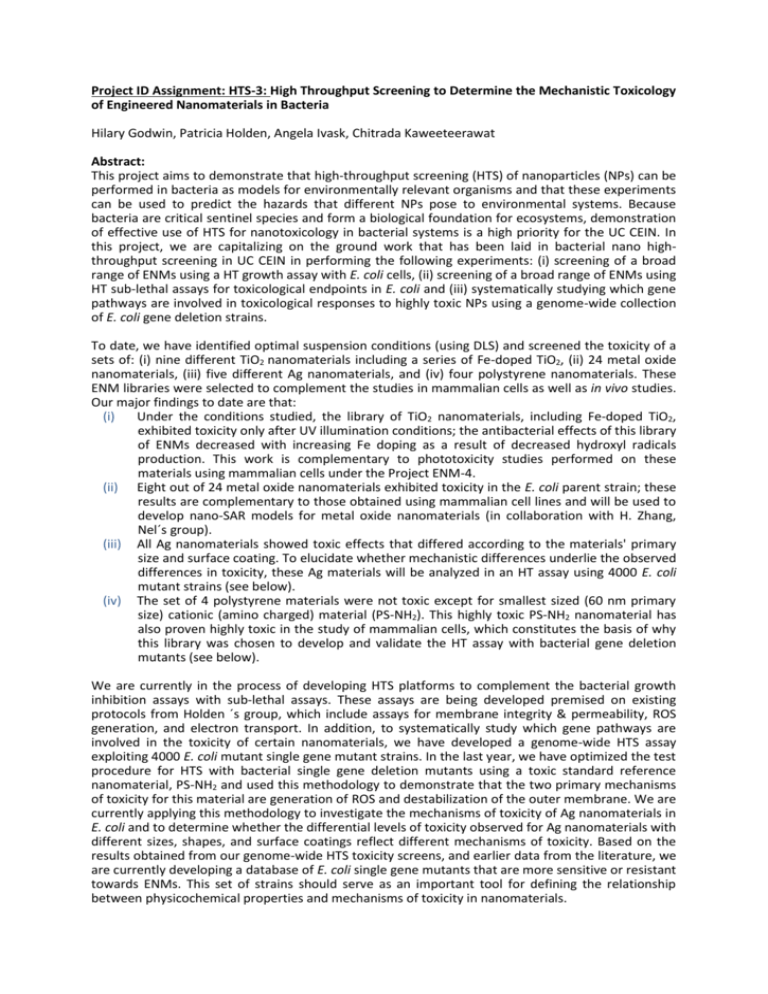
Project ID Assignment: HTS-3: High Throughput Screening to Determine the Mechanistic Toxicology of Engineered Nanomaterials in Bacteria Hilary Godwin, Patricia Holden, Angela Ivask, Chitrada Kaweeteerawat Abstract: This project aims to demonstrate that high-throughput screening (HTS) of nanoparticles (NPs) can be performed in bacteria as models for environmentally relevant organisms and that these experiments can be used to predict the hazards that different NPs pose to environmental systems. Because bacteria are critical sentinel species and form a biological foundation for ecosystems, demonstration of effective use of HTS for nanotoxicology in bacterial systems is a high priority for the UC CEIN. In this project, we are capitalizing on the ground work that has been laid in bacterial nano highthroughput screening in UC CEIN in performing the following experiments: (i) screening of a broad range of ENMs using a HT growth assay with E. coli cells, (ii) screening of a broad range of ENMs using HT sub-lethal assays for toxicological endpoints in E. coli and (iii) systematically studying which gene pathways are involved in toxicological responses to highly toxic NPs using a genome-wide collection of E. coli gene deletion strains. To date, we have identified optimal suspension conditions (using DLS) and screened the toxicity of a sets of: (i) nine different TiO2 nanomaterials including a series of Fe-doped TiO2, (ii) 24 metal oxide nanomaterials, (iii) five different Ag nanomaterials, and (iv) four polystyrene nanomaterials. These ENM libraries were selected to complement the studies in mammalian cells as well as in vivo studies. Our major findings to date are that: (i) Under the conditions studied, the library of TiO2 nanomaterials, including Fe-doped TiO2, exhibited toxicity only after UV illumination conditions; the antibacterial effects of this library of ENMs decreased with increasing Fe doping as a result of decreased hydroxyl radicals production. This work is complementary to phototoxicity studies performed on these materials using mammalian cells under the Project ENM-4. (ii) Eight out of 24 metal oxide nanomaterials exhibited toxicity in the E. coli parent strain; these results are complementary to those obtained using mammalian cell lines and will be used to develop nano-SAR models for metal oxide nanomaterials (in collaboration with H. Zhang, Nel´s group). (iii) All Ag nanomaterials showed toxic effects that differed according to the materials' primary size and surface coating. To elucidate whether mechanistic differences underlie the observed differences in toxicity, these Ag materials will be analyzed in an HT assay using 4000 E. coli mutant strains (see below). (iv) The set of 4 polystyrene materials were not toxic except for smallest sized (60 nm primary size) cationic (amino charged) material (PS-NH2). This highly toxic PS-NH2 nanomaterial has also proven highly toxic in the study of mammalian cells, which constitutes the basis of why this library was chosen to develop and validate the HT assay with bacterial gene deletion mutants (see below). We are currently in the process of developing HTS platforms to complement the bacterial growth inhibition assays with sub-lethal assays. These assays are being developed premised on existing protocols from Holden ´s group, which include assays for membrane integrity & permeability, ROS generation, and electron transport. In addition, to systematically study which gene pathways are involved in the toxicity of certain nanomaterials, we have developed a genome-wide HTS assay exploiting 4000 E. coli mutant single gene mutant strains. In the last year, we have optimized the test procedure for HTS with bacterial single gene deletion mutants using a toxic standard reference nanomaterial, PS-NH2 and used this methodology to demonstrate that the two primary mechanisms of toxicity for this material are generation of ROS and destabilization of the outer membrane. We are currently applying this methodology to investigate the mechanisms of toxicity of Ag nanomaterials in E. coli and to determine whether the differential levels of toxicity observed for Ag nanomaterials with different sizes, shapes, and surface coatings reflect different mechanisms of toxicity. Based on the results obtained from our genome-wide HTS toxicity screens, and earlier data from the literature, we are currently developing a database of E. coli single gene mutants that are more sensitive or resistant towards ENMs. This set of strains should serve as an important tool for defining the relationship between physicochemical properties and mechanisms of toxicity in nanomaterials. The impact of this work from a theme-wide perspective is that we are poised to compare bacterial HTS results to those obtained in HTS studies in mammalian cell lines and zebrafish. What is already clear is that not all particles that are toxic to organisms in one kingdom, class or phylum are necessarily toxic to all others, which reinforces the importance of the holistic approach taken by the UC CEIN in studying nanotoxicology in a broad range of platforms and organisms. At the same time, we have been able to demonstrate that the “positive control NM” (60 nm PS-NH2 NM) which is used across the UC CEIN is not only toxic across all organisms studied to date, but that at least one of the mechanisms of toxicity for this NM (ROS generation) is conserved across all of the organisms studied to date – including ones from different kingdoms. Going forward, our hope is that the sub-lethal assays in bacteria which we are transitioning to high-throughput will provide a rapid way to prioritize testing for not only bacteria, but other environmentally-relevant organisms.
